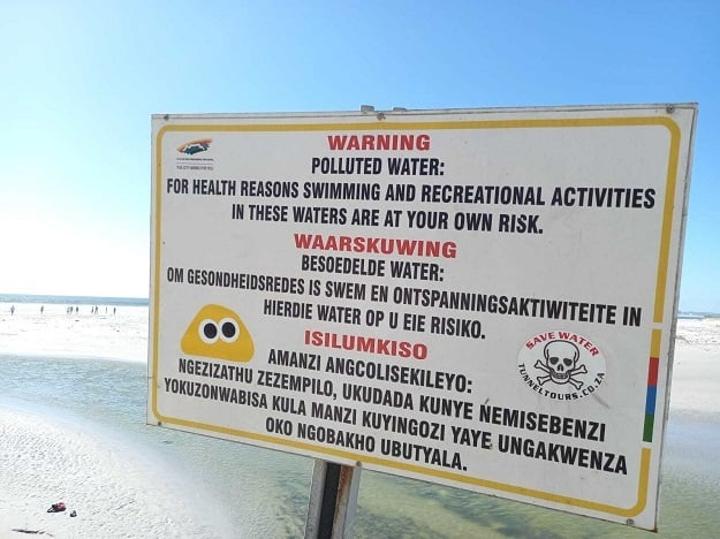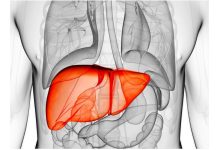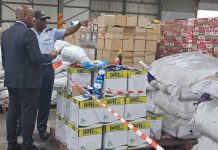Africa-Press – South-Africa. Pollution and sewage, flowing from the Diep River into the Milnerton Estuary and lagoon, and then into the sea at Lagoon Beach, did not stop people from swimming there, despite boards warning that it was polluted and closed.
Children frolicked in the clear glistening water on Wednesday despite warnings on the boards in three languages that the water was unsafe for swimming and drinking.
“Warning, polluted water: For health reasons, swimming and recreational activities in these waters are at your own risk,” read one board.
Another read: “Warning, polluted water, unfit for swimming, playing or drinking.”
The pollution is understood to cause gastroenteritis mainly.
Still, many children and adults splashed happily in the sun-warmed water, seemingly oblivious to the city’s news alert that the beach was still closed.
Some days the pollution is evident in a thick black trail, but on Wednesday, it looked like a typical day at the sea, so most of the people at Lagoon Beach enjoyed picnics and built sandcastles.
The beach was litter-free thanks to the four beach cleaners there the whole day.
“I go in for about 10 minutes, and I come out,” said one man leaning against the long promenade wall. “I have never been sick,” he said as Table Mountain and the Cape Town harbour reflected off his sunglasses.
An ice cream vendor said business had been “good” as he took a break from pushing his bicycle up and down for trade among the hookah pipe smokers and young people taking selfies.
However, out of sight and up the West Coast road along the R27 and near Milnerton High School, two men continued the smelly, months-long job of pumping sewer overflow out of a pumping site that leads to the lagoon to prevent the sludge from getting any further.
Sandbags and litter traps were also installed at critical points along the waterways. This was one of a long list of short-term measures put in place to keep the pollution out of the lagoon.
Residents’ anger over this long-standing problem has been on the boil for years and has even included intervention by the civil action organisation OUTA. At a recent community meeting, residents said they were fed up with the constant stench and the polluted water.
“It’s had a devastating impact on every level,” Caroline Marx, a director of lobby group Rethinkthestink, told News24.
“Tourists have disappeared and gone away to where it doesn’t smell. Apart from the health risks [of polluted water], there are increasing concerns about the gases in the air. Hydrogen sulfide (a sewer smell) is an irritant to the nose and an eye irritant, and it can cause sinusitis and headaches.
“And the ecosystem has totally collapsed. The crabs, the fish, the green weeds at the bottom of the lagoon are all dead.”
She warned that the lagoon’s function as a fishing breeding ground was under threat, and already subsistence fishermen were not catching anything.
“Why are we surprised when we see starving penguins and seals?” she asked.
“It has shattering implications for job opportunities and financial wellbeing.”
Marx said that in the long term, there was hope, but for the immediate and short term, there did not seem to be any urgency. She pointed to Potsdam Wastewater Treatment Plant as the primary culprit.
The Diep River runs from its source in the mountains at Riebeek Kasteel, and its final journey to the sea takes it past the Potsdam wastewater treatment plant, which has the Astron refinery rising behind it.
Once considered far from the CBD, a surge in high-density residential developments and industrial expansion has closed the gap between the city and rural land.
Marx said the plant was neglected for so long that it would take years to get it to cope with the high demand.
Some critics blamed the rapid expansion of Dunoon with its shacks and cobbled together infrastructure, or clogged canals from Joe Slovo.
“There is clear evidence that informal settlements need to be addressed, but it’s not the major problem.”
There were hopes that the much-lauded plans and tenders that are part of the next phase of the R5bn planned upgrades to the plant would get off the ground soon.
In the meantime, the city has begun extensive preparations.
Further up the coast from Lagoon Beach, excavation equipment dominated the entrance to the beach at Woodbridge Island, as the City of Cape Town carried out a large dune rehabilitation and beachfront rejuvenation project.
Surfskier Noar Lombard shook the water from his hair as he put his canoe down after a paddle.
“The Milnerton Lagoon is full of sewage, and it just goes right around into the ocean,” he explained.
Lombard said he had a few stomach bugs, which he linked to the poor water quality. But pointed out that besides the effluent problem, there was also a wider plastic problem swirling around the coast.
Milnerton Canoe Club chairperson Richard Allen said: “I want them (the council) to just start doing something.”
According to Allen, Woodbridge’s problem was that a “highway of litter” ran out of the Black River nearer Paarden Island, with raw sewage mixed in with it. It goes out to sea, leaving a slick about 2km offshore.
“It becomes ‘out of sight, out of mind’,” said Allen.
Tides, winds, and currents then start swirling it back to shore, and although it was removed by council workers and volunteers, and traps and sand banks were set up to prevent it from flowing into the sea, the problem continued.
To add to its problems, the City of Cape Town announced during its December high season that it had to temporarily close Bakoven, Muizenberg and Fish Hoek beaches – some of the most popular beaches in the city.
It said load shedding was to blame because the pump stations could not work properly, causing an effluent overflow.
The City of eThekwini may have enjoyed a moment of schadenfreude, as it deals with its own beach problems after the floods.
The City of Cape Town told News24 that the unreliable power supply meant pump stations cannot cope with the power being switched off and on, so a host of departments were trying to keep on top of it.
The City added that litter, builders’ rubble and fats that end up in the sewer network, also blocked the flow of sewage.
Larger priority sewer pump stations were fitted with permanent generators, and maintenance staff were on standby with mobile generators to use smaller pumps.
“However, with higher, prolonged stages of load shedding being experienced, sewer spills and overflows are to be expected, despite the contingency measures that are in place,” the City said.
For More News And Analysis About South-Africa Follow Africa-Press






